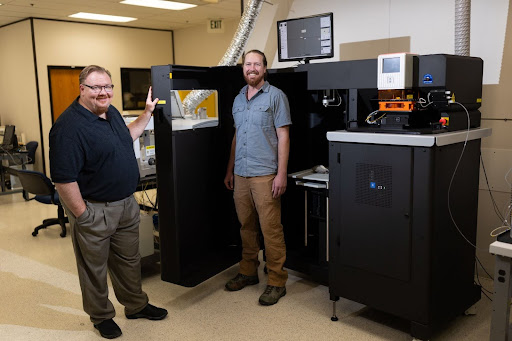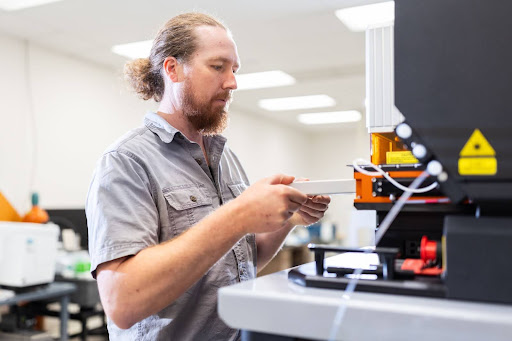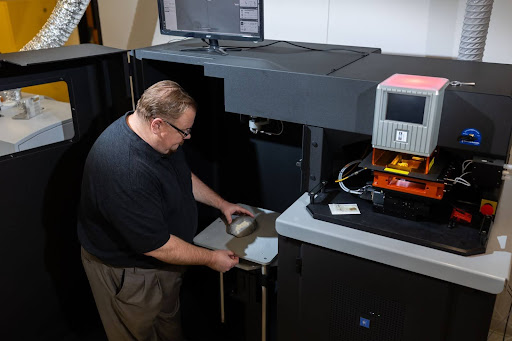Revolutionizing Research: Idaho State’s Rare Instrument Opens New Frontiers in Science

Andy Speer loads a small sample
Elisabeth Curtis
October 29, 2024
Discover how Idaho State University's newly installed state-of-the-art mass spectrometer, one of only three in the world, is revolutionizing research across multiple fields.
There are three machines of its kind in the world: One is at the Louvre Museum in France, one is at Cranfield University in the United Kingdom, and one is custom built and newly installed right here on the Idaho State University Pocatello campus in the Center for Archaeology, Materials, and Applied Spectroscopy (CAMAS) Lab at the Eames Complex.
Led by Dr. Charles A. Speer, Principal Investigator, together with Co-Principal Investigators John Dudgeon, Kathleen Lohse, and Kurt Sundell, ISU secured this machine, called the “Artifact” which is a Large Object Chamber - Laser Ablation - Triple Quadrupole - Inductively Coupled Plasma - Mass Spectrometer or LOC-LA-QQQ-ICP-MS, through a National Science Foundation grant. It’s a high-tech mass spectrometer, an Agilent 8900, combined with an incredibly precise Excimer laser. This represents the latest technology available to researchers.
This new tool will change how research is done in many fields like archaeology, biology, environmental science, and forensics. What makes this machine special is that it can analyze tiny traces of almost any material (liquids, solids, gasses). Additionally, for solid samples analysis can be done with microscopic holes thereby opening the way to test priceless artifacts and samples.
For example, it can look at ancient stone tools or mammoth tusks to understand where they came from and how they were used without breaking or harming them. It can also analyze human bones to help identify where someone lived, which could be useful in solving forensic cases, like identifying unknown migrants. Researchers can date rocks, track ancient migrations, and study environmental impacts. Unique to other sampling laser instruments, it can also handle large samples (as big as a small fridge) and test them with incredible precision. Researchers can even use it to check the purity of materials in medicine or food.
With the “Artifact”, students and faculty have an unparalleled opportunity to conduct research and learn about the world in new ways. Additionally, students have the opportunity to train on an instrument that will poise them for career opportunities that are in high demand.
Part of the grant includes a three-year graduate assistant program where students will train with Dr. Speer to become technicians qualified to use the complex instrument. Dr. Speer will also use it to teach undergraduate students how these tests are applied in fields like archaeology and anthropology, for example, by bringing his Discovery Archaeology class to the lab during class time to better understand how a high tech lab can solve ancient mysteries.
Dr. Speer explains that this opportunity is especially important for underrepresented groups, such as female, rural, Indigenous, Hispanic, and low-income students who often seek employment beyond academia, yet don’t traditionally have access to equipment of this caliber.
“Many of our students come from low-income or marginalized backgrounds, and this kind of opportunity would typically only be available at larger institutions,” Dr. Speer says. “It’s as cutting-edge as you get. Students have a unique opportunity to train on these instruments. Once these students acquire the lab and instrument skills set, they then become highly valuable to multiple private and public sector companies as laser ablation and mass spectrometry are critical to so many different industries. On top of that, it’s hard to find people trained in this niche, high tech area. All of a sudden anthropology graduates can apply for jobs across the spectrum, including the semiconductor industry, which can be highly lucrative.”
The instrument is already attracting researchers from outside ISU and fostering collaboration, making ISU a hub for advanced research. Additionally, it will make ISU more competitive for external funding and provide the opportunity for faculty and students to explore research questions previously unattainable in the region.
For Dr. Speer, this achievement is the result of over a decade of effort, marking his third attempt at securing this grant. It’s been a long journey, but now it’s a reality.
How the instrument works:
To understand how the instrument works, the laser creates a tiny hole, only 20 microns wide (about one-fifth the thickness of a human hair). The hole is so small you need a microscope to see it. When the laser hits the sample, it turns a tiny bit of it into a fine dust, which is then pushed to the mass spectrometer by argon and helium gas. Dr. Speer says that the cool thing is they can test the same piece of material many times without ruining it, and still get a lot of information from just a tiny amount of dust.
The dust is then sent into a plasma torch that’s super hot—about 10,000 to 12,000 degrees, as hot as the surface of the sun. In the torch, the dust is broken down into its basic parts. The high heat tears apart the molecules, strips away electrons, and leaves us with ionized atoms (atoms with a charge). The instrument uses magnets to separate out the different elements, and researchers can get very detailed information about what the material is made of.
Then, Dr. Speer says, the exciting work of analysis begins.
Types of Research Enabled by the Instrument:
The Louvre uses their machine to date artwork by identifying materials from the correct time period, detect forgeries, and analyze the composition of the materials. It allows them to determine the exact materials used in each piece without destroying the priceless art. What type of application will researchers at ISU be able to employ? This state-of-the-art instrument enables trace (parts per million to parts per billion) and ultra-trace analysis (parts per trillion to parts per quadrillion), making it the next step in elemental and materials analysis across multiple fields. According to Dr. Speer: “This is pushing the limits of current technology.”
Forensic Anthropology
In the field of forensic anthropology, the instrument has significant potential for identifying unknown migrants who pass away during border crossings. By analyzing bones and teeth through strontium isotope studies, researchers can trace an individual's geographic history, potentially linking remains to specific regions. This capability not only aids in the identification of bodies but also helps reunite families with their lost loved ones by building a comprehensive database.
Paleontology and Ancient Migration Studies
When it comes to paleontology and ancient migration studies, the instrument can analyze the layered growth of mammoth tusks, which provide insights into the animals' movements across ancient landscapes like the Snake River Plain during the last ice age. Researchers can map out migration routes and establish connections to other species and early human hunters, enhancing our understanding of these historical ecosystems.
Archaeology
In archaeology, the instrument allows for detailed stone tool analysis by determining the elemental composition of artifacts. This analysis enables researchers to trace the origins of these tools and uncover patterns of ancient human migration and trade. Such insights contribute to our understanding of early human behaviors and interactions across different regions.
Geology and Environmental Science
In the realms of geology and environmental science, the instrument serves dual purposes. It can date zircon crystals and analyze rock samples, offering invaluable insights into millions or even billions of years of Earth's geological history. Additionally, it assesses water quality by measuring essential elements like calcium or detecting harmful contaminants such as arsenic in agricultural products like rice.
Art and Artifact Conservation
The instrument also plays a vital role in art authentication and conservation. It can analyze materials from artworks and artifacts without causing damage, helping to determine their authenticity by identifying whether the materials align with the time periods of the pieces. This non-destructive approach ensures the preservation of priceless collections.
Consumer Science and Pharmaceuticals
In consumer science and pharmaceuticals, the instrument's ability to conduct purity and safety testing is crucial. It can evaluate the purity of various chemicals, such as silicon matrices in the computer industry or selenium levels in livestock. Furthermore, it serves an essential function in the pharmaceutical sector by ensuring the purity of medications, thereby safeguarding public health.
Collaboration Across Disciplines
The instrument fosters collaboration across multiple disciplines. Forensic anthropologists, such as Dr. Dudgeon, will utilize it for diverse research projects, including the study of ancient human behaviors through artifacts and skeletal remains. In environmental science, Dr. Loshe will lead initiatives focused on water analysis to explore the environmental impacts on human and animal health. Meanwhile, Dr. Sundell will apply the instrument to zircon crystal dating, contributing significantly to the research of Earth's geological history.
With this state-of-the-art instrument, Idaho State University is now at the forefront of cutting-edge research, enabling breakthroughs in fields like archaeology, forensic science, geology, and environmental studies. This technology gives students and faculty the ability to analyze materials with unmatched precision, all while preserving the integrity of the samples.
By providing unique opportunities for hands-on experience, the “Artifact” positions ISU students to enter high-demand careers and collaborate on research projects that were once only possible at larger institutions. This new instrument not only elevates ISU's research capabilities but also opens doors for faculty and students to contribute to meaningful scientific discoveries on a global scale.

Andy Speer, left, and Christian Gattung pose for a photo beside ISU's new mass spectrometer and laser ablation system on Friday, October 25, 2024.

Cheyenne Eartelt, a master's student in geology, loads Zircon samples into ISU's mass spectrometer and laser ablation system on Friday, October 25, 2024.

Christian Gattung, a master's student studying anthropology, loads samples into ISU's new mass spectrometer and laser ablation system on Friday, October 25, 2024.

ISU’s new instrument allows for larger sample sizes than have been possible before. Andy Speer loads a sample in the sample chamber, which is about the size of a mini-fridge.
